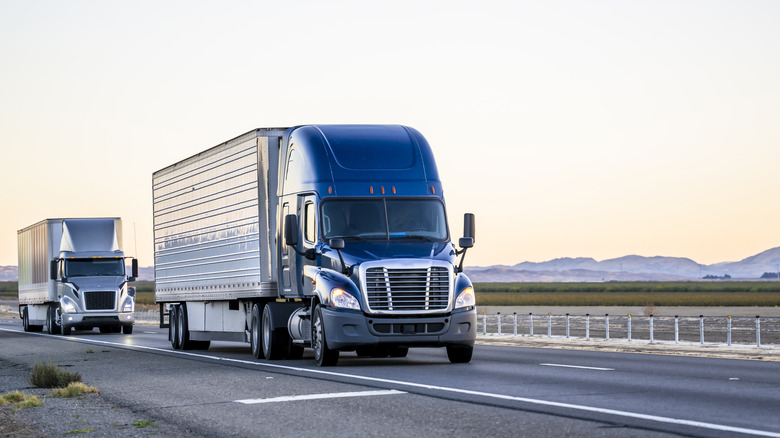What Is The Legal Top Speed Of A Semi-Truck On US Freeways?
Semi-trucks can be so slow on the highway, causing enough frustration amongst drivers to attempt passing them on the right. Being stuck behind or in between these gargantuan gas-guzzlers can delay you while also making it difficult to see the road ahead. However, those unfamiliar with semi-truck regulations may be unaware that there are legal reasons for their driving slower than the flow of traffic. Depending on where you reside in the United States, semis may be subject to lower speed limits than other vehicles.
This isn't the case everywhere, as a majority of states permit big rigs to reach the same speeds as others on the road — usually between 65 and 70 miles per hour, according to the Insurance Institute for Highway Safety (IIHS). The highest average listed is Texas, which allows top speeds of 75 mph across both rural and state interstates. Certain states such as Oklahoma and Utah even permit upwards of 80 mph speeds for specific road segments.
The only states that currently require trucks to drive at different speeds on specific highways are Arkansas, California, Idaho, Michigan, Oregon, and Washington, with the highest being 70 mph. California requires trucks to maintain 55 mph across all interstates and roads. However, even if your area lets semi-trucks drive faster, there's a good reason why they shouldn't.
Plans are in place to help control semi speeds
Passenger vehicles might be at risk of receiving a $1 million ticket for speeding, but speeding in a semi-truck is playing a more dangerous game. The overwhelming size of these machines means they need a significant distance to stop completely. A fully-loaded semi requires over 500 feet of stopping distance while driving under normal weather conditions at an average speed. The distance increases the faster the truck is moving or if the road conditions are worse, making it imperative for truck drivers to maintain as steady a speed as possible.
While governed speed limits can help cut down on incidents, more extreme measures are being taken to keep truck drivers in check. Companies such as Schneider mandate their own speed limits, oftentimes lower than those put in place by lawmakers. However, a more recent change that's come about could see an even more drastic and widespread change. In 2023, it was announced that the Federal Motor Carrier Safety Administration (FMCSA) would make it mandatory that all commercial vehicles over 26,001 pounds to be equipped with electronic speed limiters.
Though it has yet to go into effect , it has proven to be a controversial mandate. Organizations such as the Owner-Operator Independent Drivers Association Foundation (OOIDA) have opposed it, with worries that it will increase the chances of dangerous interactions between trucks and passenger vehicles. However, the FMSCA is still likely implement the directive, regardless.

